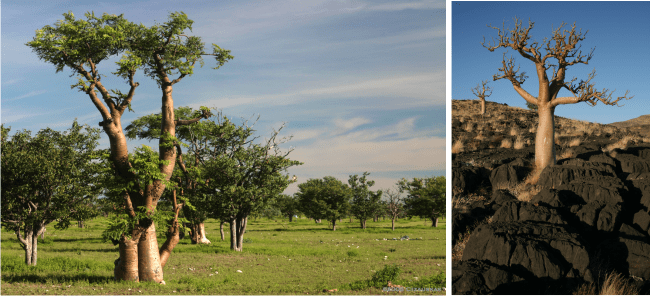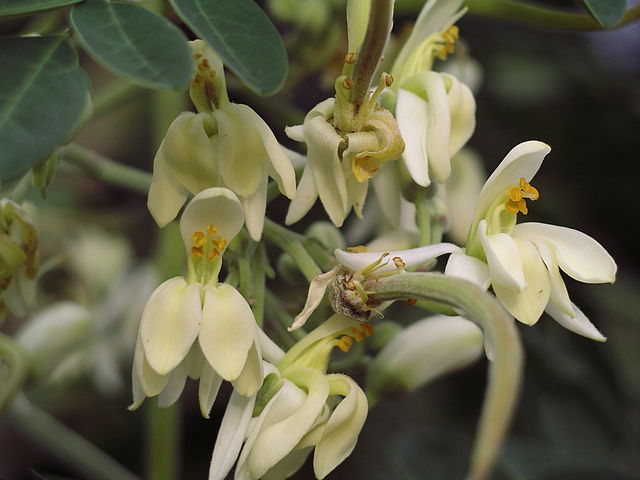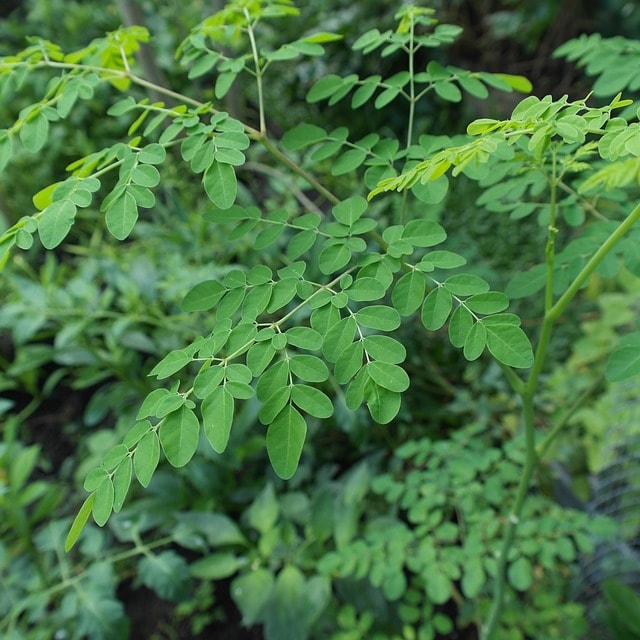If you live in the East you’ll surely know about moringa. But if you don’t, you need to be really passionate about eating healthy superfoods to hear about it. And I’m sure you’ve wondered: What is moringa honey and where can be found? And what is moringa leaf powder?
How super is this superfood? It is considered that they are all amazing, though some info will tell you for example that moringa is way superior to kale.
The funny thing is that while Easterners eat it on a regular bases, like we eat spinach for example, without considering it more than food, Westerners say it’s a miracle plant and make supplements out of it.
Moringa can be compared to neem or the black seeds – though each have different composition. And as usual, mixing them with honey will increase their health benefits on you. Besides this combination, these plants have flowers full of nectar, offering humanity some precious healthy honey. Pretty rare though.
Moringa honey
This is real moringa honey, not the infused type, produced by honey bees from the nectar of moringa flowers. It’s dark brown with a rich and thick consistency. I couldn’t find any info regarding the chemical components of this honey yet.
• Amazon.com offers you moringa honey produced in Haiti. Moringa Flower Pure Raw Mono-floral Honey – Retains Calcium in Body, Prevents Heart Disease- Monofloral Dark Honey- 8 Ounces.
The reviews are good. There were some issues at one customer who received an exceptional honey at his first order but an “awful” one at his second order. Too bad he didn’t post the producer’s explanations he subsequently requested.
“one of the best honey money can buy” says on May 9, 2017, on the Amazon review page.
Moringa infused honey
While this is not real honey, the infused one is just as healthy, though its flavor is more powerful. The leaves are infused in raw cold honey for a period of time and than extracted, or the honey is simply mixed with moringa powder.
• Moringa Farm Australia sells Premium & Ultra Premium range of Moringa honey here. They use grown and processed moringa from Australia mixed with rainforest & tropical flowers honey, creating thus “moringa honey” – which they say “seriously and comprehensively surpassed any genuine ‘Manuka’ or ‘Jellybush’ types of honey in bio-activity, nutrient range, & nutrient amounts.”
• Delicious and super nutritious – this is how a producer from Zambia describes their product. The recipe is quite simple: they mix raw organic honey from Zambia and infuse it with Moringex®Moringa extract. An easy-to-drink mixture that combines the benefits of 2 superfoods. Also selling moringa honey, though I don’t know if they ship internationally.
Do It Yourself!
Mix raw honey with moringa powder, just like you mix honey with black seeds powder or with turmeric. Take it three times per day.
What is Moringa?
A tree. It’s native to Africa and Asia, but it grows in all tropical and subtropical climates. It’s a tree like a Himalayan ascetic, grows in poor soil and requires little water.
Its family, Moringaceae, contains 13 species, varying from tiny herbs to big trees.
The moringa we are referring here is Moringa oleifera, fast-growing and very drought-resistant, native to the foothills of the Himalayas and cultivated today throughout the tropics and subtropics.
Other names: drumstick tree (from the appearance of the long, slender, triangular seed-pods), horseradish tree (the taste of its roots resembles horseradish), ben oil tree, or benzoil tree (from the oil which is derived from the seeds).
 picture source Carrie Cizauskas and Vernon Swanepoel via flickr.com, under CC
picture source Carrie Cizauskas and Vernon Swanepoel via flickr.com, under CC

The flowers are fragrant and bisexual, surrounded by five unequal, thinly veined, yellowish-white petals. They grow on slender, hairy stalks in spreading or drooping flower clusters.
Flowering begins within the first six months after planting. Flowering happens once a year in cool regions, or twice or all year-round in areas with a constant rainfall.
It makes a fruit, a long, slender, triangular seed-pod. It’s a capsule with 3 sides which holds dark brown, globular seeds with a diameter around 1 cm. The seeds have three whitish papery wings and are dispersed by wind and water.
The leaves are the most important part of this tree. While there are other parts edible, leaves are the most nutritious of all.

The tree yields best under warm, dry conditions with some supplemental fertilizer and irrigation. The leaves and stems can be harvested from the young plants 60 days after seeding and then another seven times in the year. In some production systems, the leaves are harvested every 2 weeks. At every harvest, the plants are cut back to within 60 cm of the ground, so the tree doesn’t grow too high thus making it difficult to harvest.
the most nutrient-dense green on the planet!
Nutritionists consider 1 serving (8g or ~1 tbsp) of raw moringa leaf powder and took shared the following gram per gram nutrition facts in moringa:
9x PROTEIN of plain yogurt
10x VITAMIN A of carrots
15x POTASSIUM of bananas
25x IRON of spinach
17x CALCIUM of milk
What is moringa good for?
According to the Ayurvedic system of medicine, moringa can cure or prevent around 300 diseases. (Fahey and Thurber, 2009)
According to webmd.com, here are the claimed uses, though further scientific evidence is needed.
Recommended doses: Moringa has been used safely in doses up to 6 grams daily for up to 3 weeks.
TAKEN BY MOUTH
- Asthma. In an early study, taking 3 grams of moringa twice daily for three weeks reduced asthma symptoms and the severity of asthma attacks in adults.
- Increasing breast milk production. Early evidence suggests that taking 250 mg of a specific moringa supplement (Natalac Capsule For Lactating Mothers
) twice daily after childbirth increases breast milk production.
- “Tired blood” (anemia).
Arthritis.
-
- Cancer.
- Constipation.
- Birth control.
- Diabetes.
- Diarrhea.
- Epilepsy.
- Stomach pain (gastritis).
- Stomach and intestinal ulcers.
- Headache.
- Heart problems.
- High blood pressure.
- Kidney stones.
- Swelling (inflammation).
- Thyroid disorders.
- Infections.
- As a nutritional supplement.
- Stimulating immunity.
- Increasing sex drive.
- Other conditions.
APPLIED TO THE SKIN
- Athlete’s foot.
- Dandruff.
- Warts.
- Skin infections.
- Snakebites.
- Gum disease (gingivitis).
- Other conditions.
Moringa is food!
Moringa is an important food source in some parts of the world. It can be grown cheaply and easily. The leaves retain lots of vitamins and minerals when dried and thus moringa is used in India and Africa in feeding programs to fight malnutrition. It’s common in India, Pakistan, Bangladesh, and Afghanistan.
According to Optima of Africa, Ltd., a group that has been working with the tree in Tanzania, “25 grams daily of Moringa Leaf Powder will give a child the following recommended daily allowances: Protein 42%, Calcium 125%, Magnesium 61%, Potassium 41%, Iron 71%, Vitamin A 272%, and Vitamin C 22%.” These numbers are particularly astounding; considering this nutrition is available when other food sources may be scarce.
The edible parts of moringa include:
- Immature seed pods, aka “drumsticks”, which are commonly consumed in South Asia. They are prepared similarly to green beans by parboiling, and cooked in curry until soft. Even they are boiled, the seed pods remain particularly high in vitamin C and are also a good source of dietary fiber, potassium, magnesium, and manganese.
- Leaves are cooked and used like spinach, but the powder obtained after drying and grinding is used in soups and sauces.
- Mature seeds are eaten like peas or roasted like nuts, contain high levels of vitamin C and moderate amounts of B vitamins and dietary minerals.
- Oil pressed from seeds. (The seed cake remaining after oil extraction is used as a fertilizer and also to purify well water and to remove salt from seawater.)
- Flowers and especially the honey resulting from their nectar
- The roots are shredded and used as a condiment with sharp flavor qualities deriving from significant content of polyphenols.
WebMD advice us to eat the leaves, fruit, and seeds, as they might be safe when eaten as food, but not the roots, too. They may contain a toxic substance that can cause paralysis and death. Even more, pregnant women should avoid the root, bark or flowers. Chemicals in this parts can make the uterus contract, and this might cause a miscarriage.
Why is moringa powder that good?
Because these leaves contain all the essential amino acids and nutrients to build strong healthy bodies:
· 92 Nutrients
· 46 Antioxidants
· 36 Anti-Inflammatory agents
· 18 Amino Acids, 9 Essential Amino Acids
· all the Omegas 3, 6, and 9.
· Zeatin – several thousand times more Zeatin than any other known plant – which has undeniable youth-preserving effects due to its ability to regulate cell division & growth, plus delay cell aging.
Monica G.Marcu Pharm.D. PH.D. shares all nutritional facts about Moringa oleifera in her book “Miracle Tree” .
Use it as soap!
Moringa oleifera leaf powder is as effective as soap for hand washing. The powder should be wetted in advance to enable anti-septic and detergent properties from phytochemicals in the leaves.
Use it to clarify regular honey!
In Sudan beekeepers and honey producers use powdered Moringa seeds to clarify honey or sugarcane juice. The seeds are not boiled first, but turned directly into powder.
!Do not confuse moringa honey with morinda honey. They come from completely different plants, though the name is almost the same. Read here what is Morinda honey.
==========
=========
References:
hmoringafarmaustralia.com.au
https://s3.amazonaws.com/kulikuli-public/moringa-poster.pdf
http://www.webmd.com/vitamins-supplements/ingredientmono-1242-moringa.aspx?activeingredientid=1242;
https://en.wikipedia.org/wiki/Moringa_oleifera

